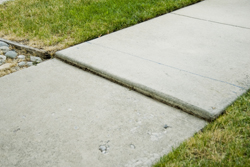OSHA guidelines define a reasonable measure of slip-resistance as a static coefficient of friction (COF). A COF of 0.50, which is based upon studies by the University of Michigan and reported in "Work Surface Friction Definitions, Laboratory and Field Measurements, and a Comprehensive Bibliography," is recommended as a guide to achieve proper slip resistance.
Since OSHA designates a reasonable measure of slip-resistance of 0.50, sidewalk repairs that do not meet this minimum slip-resistance represent a potential liability and continued trip hazard.
Our patented saw-cutting technology completely and cleanly removes not only trip hazards from sidewalks but leaves a micro-textured finish on the repair that is equal to or exceeds OSHA standards for adequate slip-resistance. By having Precision Safe Sidewalks remove their trip hazards, our clients reduce their legal liability using the most efficient and cost effective method available.
• Each offset will be tapered according to the specifications requested by the client and will have a smooth, uniform appearance and texture that meets or exceeds OSHA guidelines for slip resistance.
• The raised sidewalk will be cut from edge to edge and brought to a zero point of differential settlement, completely eliminating the trip hazard.













